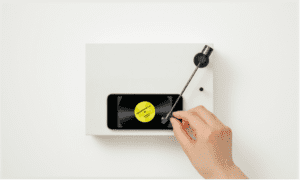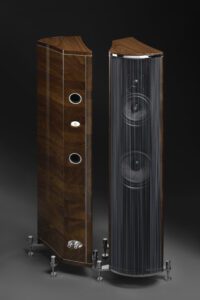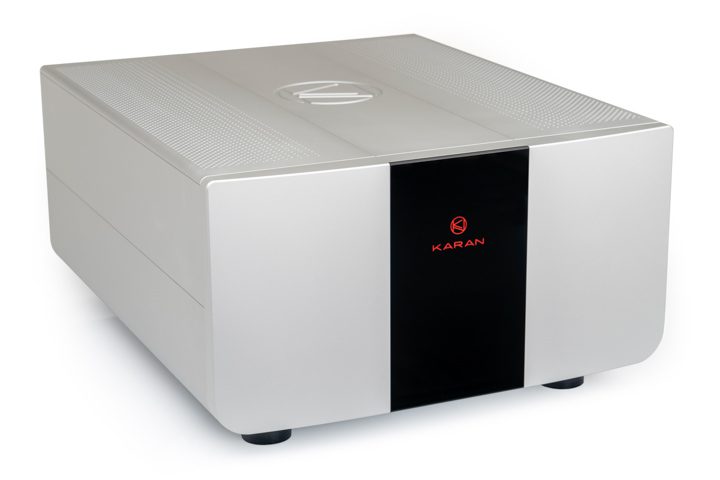
Milan Karan’s Master Collection portfolio of preamplifiers and power amplifiers is a step-change in the company’s design, leveraging decades of knowing how to make a good amplifier to produce the best product in the category. The first two out of the starting gates were the two box LINEa (reviewed in Issue 181) and single box LINEb (reviewed in Issue 191) preamplifiers, with the promise of stereo and mono power amplifiers and phono stages to follow. The Master Collection POWERa Mono amp is the first of this second wave of new electronics from the brand, and it more than lives up to the standards set by the preamps.
Oddly, although they are no strangers to the magazine, we have never formally looked at any of Karan Acoustics ‘big’ stereo or mono power amplifiers. Except for the ‘smaller’ KA M 650 monoblocks (reviewed in Issue 56), we only ever used them in the context of other reviews. It’s time to redress this error.
Both stereo and mono variants of the POWERa launched only a few months ago, and the big monoblocks were a natural choice for the first review. Leading the Karan range for almost two decades, the KA M 1200s and, lately, KA M 2000s mono amplifiers defined a standard of design and sonic performance that would never be easy to beat and outperform. So, to do so, Milan Karan has pulled out all the stops when designing the POWERa amplifiers.
From the ground up
Everything inside the impressive genuine differential mono chassis shell is improved and redesigned from the ground up. While the output (power) circuits still implement the very best Sanken bipolar output devices, the power supplies and their accompanying audio infrastructure have been extensively reworked. The same applies to the input (driver) stages, with high-grade Audyn and superior, proprietary Karan Acoustics capacitors used throughout. The component list of greats includes Vishay and Roederstein resistors and Cardas Audio’s highest quality chassis wire. That, however, is not all. As with all Karan mono amplifiers, each ‘polarity half’ of each audio channel (i.e. amplifier) has its independent mains transformer and accompanying power supply; this also means we need two mains cables for each amplifier!
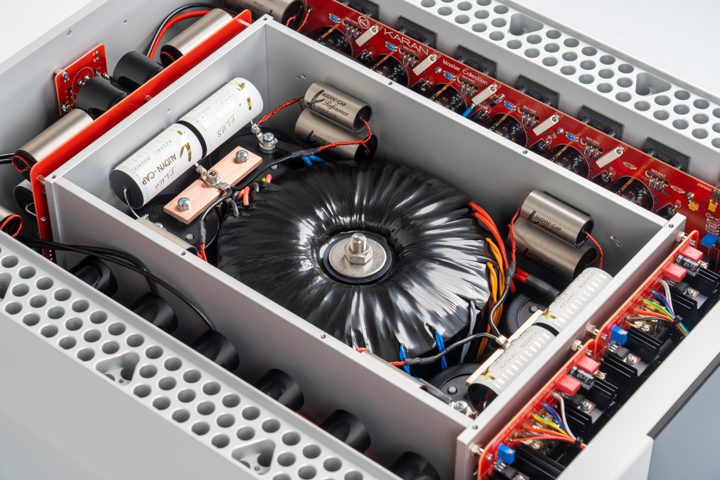
For the POWERa amplifiers, Karan developed new, much bigger, more powerful, and mechanically quieter toroidal transformers. That resulted in a proportionally enlarged battery of power supply reservoir capacitors of equally high-grade specifications, giving the circuits an even greater reserve of power and current and ultra-quickly available from stock. As before, speaker terminals and RCA inputs stem from WBT, while Neutrik caters for the XLR input interface.
This amplifier’s power output is impressive even by the brute-force standards of some of the biggest big hitters. It puts out an impressive 2,150W into eight ohms and pulls up to 6kW into two ohms, and you can see why it needs two power cables per chassis. In use, that doesn’t just mean it can make a wall sing if you give it some speaker terminals; it means the amps will deliver the signal’s total bandwidth and dynamic headroom into any loudspeaker load while delivering the potential for excellent transient speed and extremely silent circuit operation.
The innards of the new Master Collection power amplifiers hide another new feature; in the main chassis of all POWER models is an advanced mains (line) conditioner with the primary goal of dealing with and eliminating as much (if not all) of the unwanted DC related by-products of our electricity supply! The amplifier has a switch on the back panel allowing you to hear the sound with or without the conditioner/DC filter in use or not. You can even do this while the amplifier is switched on and playing music! While there are few categories in audio as contended as the line conditioner/DC filter market, I’d like to see this offered as a separate, universal product within the Karan Acoustics product range.
Ask Milan
When asked about this part of the design, Milan Karan said, “I believe that having our own design and solution for the treatment of unwanted DC artefacts from the mains supply is at least as important as all other circuit innovations within the Master Collection POWER amplifiers. What would be the point of having huge and capable mains transformers and other power components (which often contribute to the ultimate sound of any amplifier than the actual audio circuits) if the electricity entering the amplifier were not to be of the same, high standard?
“To make something complex sound as simple as possible, let us say that any supply of electricity also includes various ‘unwanted’ elements. Let’s just consider how many domestic electrical appliances and/or consumers tend to be powered through the electricity supply network at all times. They generate a huge number of spurious by-products as a consequence of how poorly their own power supplies may have been designed. And, for as long as they remain powered up, those ‘dirty’ components are fed back into the network and, consequently, into all other consumers, equally so switched on! Not just high-end audio components, everything! The most parasitic pollution is of a DC (direct current) nature. This, quite damaging for audio components in particular, part of our electricity, reflects itself as a DC voltage that can be either positive or negative, and has an amplitude of up to several Volts!
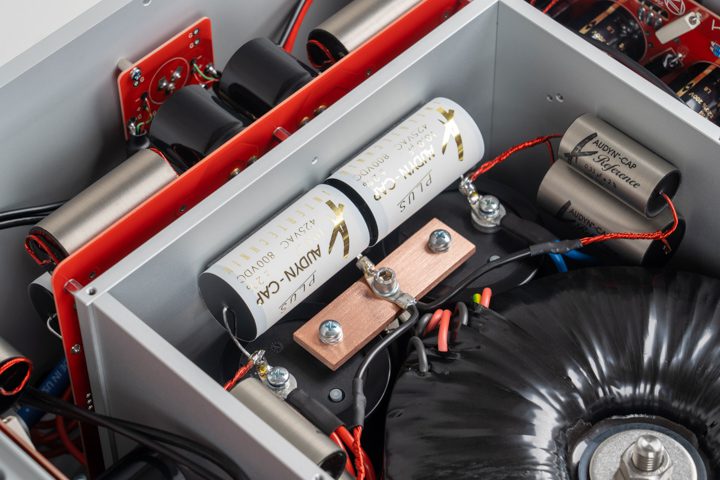
“The higher this DC voltage may be, the more saturation attacks mains transformer cores within all amplifiers. Temperature of the transformer windings will rise because they feel the DC voltage almost as a short (circuit)! Transformers will begin to vibrate mechanically to a various, often high degree. We perceive this as an unpleasant mechanical vibration, like a buzz, from the amplifiers within one’s listening room. The bigger the mains transformers, the more sensitive to the parasitic DC voltage they are, and the louder the mechanical vibrations will be.
“That is not all, however. This also brings a problem with the Neutral side of the mains as a phase shift will develop, the severity of which depends on how badly high the parasitic DC voltage may be. This, ultimately, prevents the sine wave to be correctly and perfectly shaped. Negative effects on the operational performance of an amplifier and overall sound quality because of these mains anomalies are substantial!
“In order to protect an amplifier of such a (high) power output as in Master Collection POWER models, designing a suitable line conditioner with an efficient DC ‘eliminator’ was anything but easy. The main criterion was that the device had no negative influence on the inherent sound of the amplifier. Further, it had to be the very generously specified in terms of current and voltage flow from the mains supply, so it would cater for at least three times more than the maximum required. In real life that meant a rating of 60A or more. We are proud our mains (line) conditioners inside the new POWER amplifiers comfortably meet and exceed those and many other criteria. Plus, the additional bonus of an on/off switch function enabling the user to perform direct comparison of its effects at any time while the amplifier is in active use.”
Crucial function
I’ve spoken to a few amp designers about power conditioning before, but it’s rare to get such a succinct and impassioned response, so I included it verbatim. This is a crucial function of the Master Reference concept, as is the clever, elegant chassis.
The new chassis concept is a highly effective circuit resonance damping system too. Increasing the mass is the most apparent solution toward superior overall damping. Still, the problem then becomes lots of the wrong kind of metal can cause more harm than good and using just a giant lump of aluminium to mass-load the amplifier ends up being a source of resonance in its own right.
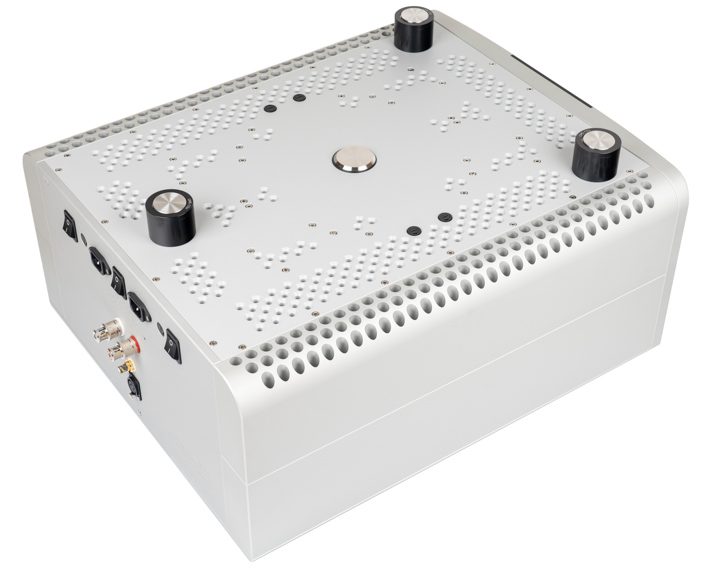
Karan Acoustics designed the main chassis to counter both concerns as a single-piece unibody made from a solid CNC-machined piece of very high-grade aluminium; this acts as a heatsink for the output devices while creating a non-resonant environment for the entire amplifier. This also helps to lower the noise floor of the amplifier itself. Continuing down the ‘impressive specifications’ line, all 105kgs of weight (per amplifier) are supported on three Critical Mass Systems CS2 1.5 supporting feet. The amplifiers are shipped in wooden crates, bringing the total shipping weight to 130kg per amplifier. Put another way; each one weighs more than a professional rugby player!
A good, big amplifier needs to do several things well; it needs to be essentially effortless in performance, with the power and headroom to express the preamplifier’s demands to the loudspeakers without getting in the way at all, but that’s a given. It also needs to have a significant sense of scale and speed so it doesn’t just sound like a big amplifier all the time. When you get to the top tier of power amplifiers, that should be a given too. But often isn’t.
Scintilating performance
However, what you get with the Karan is so much more. It’s a scintillating performance, showing you what the devices upstream and down are capable of and also pointing out where other amplifiers get it very wrong. This is the antidote to those amplifiers that push sound at you; initially impressive but ultimately wearing. Typically, that ‘doesn’t push music at you’ is code for ‘it sounds dull and dreary’, but in this case, the treble sparkles, and the midrange is clear and quicksilver fast.
The more time you spend with the top-end amplifiers, the more you realise there is usually some trade-off, even with the best of them. Some are faster at the expense of dynamics, and some vice versa. Some do detail and stellar high-frequency reproduction at the expense of making the sound too ‘in yer face’ exuberant and exciting. However, when you encounter an amplifier that doesn’t make those compromises, you discover just how common they are. The Karan Master Reference POWERa Mono amps are the amps that don’t compromise.
How this comes across is simple. Play a piece of music. It doesn’t matter what that piece of music is, just something you know well. It was ‘Entr’acte’ from Orange by Caroline Shaw and the Attacca Quartet [Nonesuch]. Other amplifiers will play you all the details in the string noises and the rest. Some will tease out the rhythmic or dynamic elements of this recording or maybe show its pace and speed.
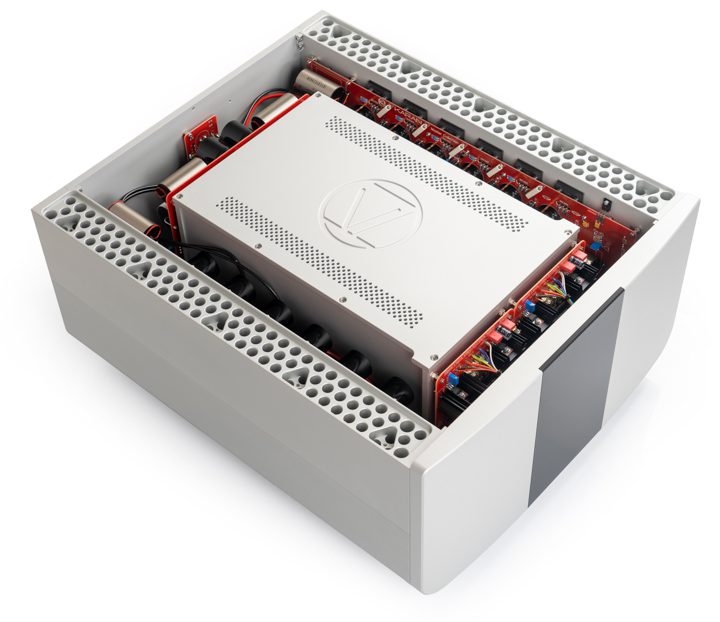
Eventually, they will begin to push past that initial ‘signature’ and show the recording in its complete form. The Karan amps give you the whole picture right from the opening bar. This could be unnerving but, in fact, is thrilling. It’s like hearing the recording for the first time or much more like hearing it live. Or, it’s like the first time you heard good audio, revising how you appreciate recorded music. In short, it’s that good.
All those usual aspects of performance are moved out of the way. You realise that discussing stereo soundstaging or vocal articulation is praising a product for not doing its job correctly. Those terms fall away when you hear it done right through the Karans. All that’s left is music. Sure, if you play Trentemøller’s ‘Chameleon’ [The Last Resort, Poker Flat] or Boris Blank’s ‘Electrified’ from the album of the same name [Polydor], the POWERa’s ability to grab hold of the bass and shake it out through your internal organs is deeply impressive. And it makes your loudspeakers seem physically larger when called upon in that manner.
But that’s only the start of what this is all about. Bass that treats your body to a spot of food processing is easy; listening to those synthesised pieces of music and finding the subtlety and instrumentation hidden below – and having that musical epiphany presented instantly – is something rare and to be treasured.
The Time Machine
I touched on this earlier, but where good audio is a time machine, putting you back to the point when you first heard that album, good audio takes you back to the first time you heard what hi-fi can do. The trouble with that experience is it is fleeting, and many of us spend a fortune trying to replicate and hold onto that feeling we got the first time we heard good audio.
Addiction specialists might talk about ‘reward centres’ in the brain and how that kind of fleeting ‘high’ creates a need in the addict, but with audio, the POWERa Mono resets your musical and audio levels each time you play a track; you get that ‘first time I heard it’ feeling repeatedly.
Then there’s the scale issue. Sounds played through the POWERa Mono are ‘right sized’ whatever you play. Move from a sizeable orchestral piece to something more small scale and vocal, and the Karan amps move with you effortlessly. Once again, this is something you realise more by recalling other amplifiers that do almost the same thing. This scales perfectly well, with no sign of either ‘tiny orchestra syndrome’ or ‘Attack of the 50ft Woman’ problems and to do that so thoroughly is exceptionally rare.

To summarise the Karan Acoustics Master Collection POWERa Mono in musical terms, I need ‘Spitfire’ from Public Service Broadcasting’s Inform Educate Entertain album [Test Card]. It’s not a demonstration quality track; just a pounding rhythm coupled to some noisy samples from the 1942 British movie, The First of The Few. It’s easy to get it wholly wrong on a big system, but get it right, and I’m back building Airfix kits; and this got it so right, I could smell Humbrol enamel!
The only downside to these amplifiers is that they spell the end for Karan’s existing KA M line of power amps. While these big power amps are not in the same sonic league as the Master Collection models, they are (somewhat) more affordable. I doubt something like the KA M 2000 would be a steppingstone to the POWERa Mono (and there will likely be a POWERb line that would make such jumps even harder to justify). Nevertheless, it would be nice to have something more attainably priced in the Karan portfolio just to make the Master Collection even more of a goal for some.
Endless Scale
That’s nit-picky, however, as the Master Collection POWERa Mono is the best balance of performance in terms of sheer power output and the quality of that power that you can get right now. This is an amplifier with endless scale, and dynamic range yet doesn’t shout about those properties… simply letting you know they are there when you need them. An amplifier at once capable of brute force and terrific refinement sets the Karans apart from the pack.
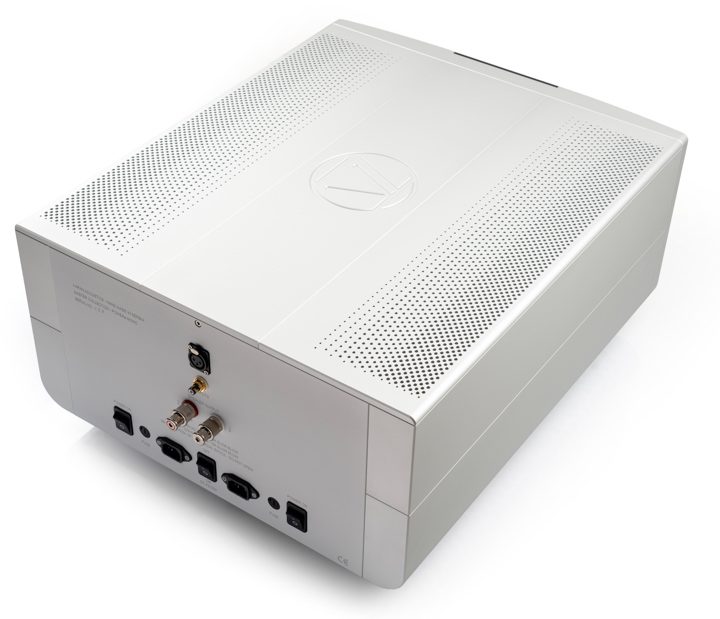
There are some exceptional amplifiers on the market at the top end, and there’s a solid argument to say there’s one no one path up that mountain (the long-winded version of YMMV: ‘Your Mileage May Vary’). But there is a personal path up that mountain, and for me, that means the Karan Acoustics Master Collection POWERa mono power amplifiers. They are the best amplifiers I have heard so far.
TECHNICAL SPECIFICATIONS
- Type: Mono solid-state power amplifiers
- Power output: 2.1kW into 8Ω, 3.6kW into 4Ω, 6kW into 2Ω
- Peak power output: 2.4kW at 8Ω
- Inputs: 1 balanced (XLR) and 1 unbalanced (RCA)
- Input impedance: 30kΩ (balanced/unbalanced)
- Input sensitivity: 2.0V/RMS (for max output)
- Frequency Response: 20Hz-20kHz ±0dB, DC-300kHz, -3dB
- Gain: +36dB
- Distortion THD/IMD: 0.03%
- Signal to noise ratio: >120dB unweighted
- Dimensions (W×H×D): 50.4 × 29.2 × 60.3cm per amplifier
- Weight: 105kg per amplifier
- Price: £79,995 per pair
Manufacturer: Karan Acoustics
URL: karanacoustics.com
UK distributor: Audiofreaks
URL: audiofreaks.co.uk
Tel: +(0)208 948 4153
Tags: KARAN ACOUSTICS MASTER COLLECTION POWERA MONO MONO POWER AMPLIFIERS
By Alan Sircom
More articles from this authorRead Next From Review
See all
PrimaLuna EVO 100 phono preamplifier
- Apr 22, 2024

Reiki Audio SuperSwitch Master Pro + Servant Pro
- Mar 27, 2024

Melco Audio N1-S38 music server
- Mar 27, 2024








